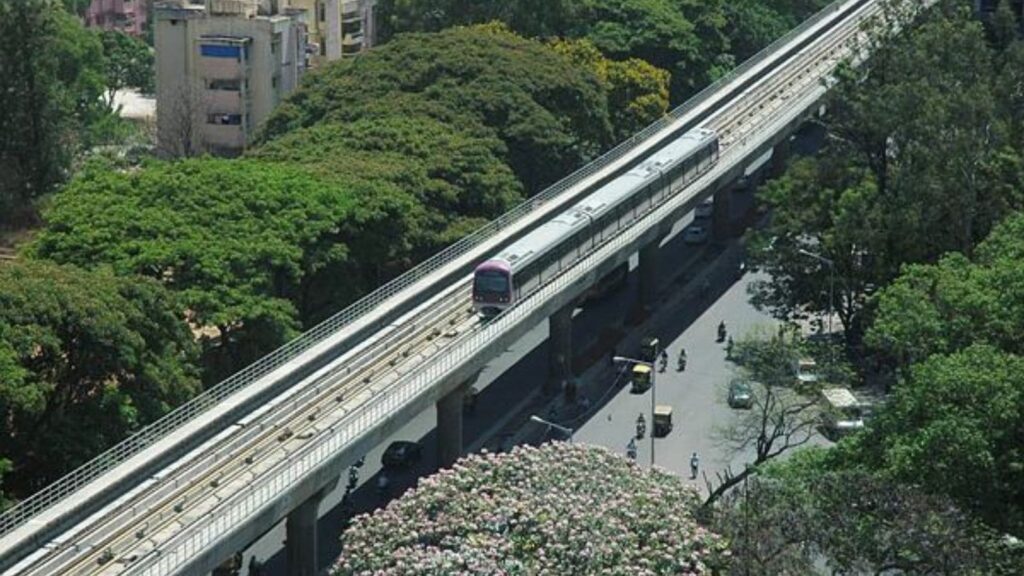After a delay of eight years, Bengaluru Metro’s much-anticipated 19.15-km Yellow Line will finally be inaugurated by Prime Minister Narendra Modi on August 10. The corridor connects RV Road and Bommasandra and links Bengaluru South to key manufacturing and tech firms located at Electronic City, including Infosys, Biocon, and TCS. Consisting of 16 stations, the new line will increase the metro rail network to 96 km and is expected to significantly decongest traffic especially near the infamous Silk Board Junction.
However, the project was dogged by several issues ranging from land acquisition delays to rolling stock production amplified by the India-China conflict. Here’s a breakdown of how the project went off track and fell back in line to completion.
A timeline of missed deadlines and bottlenecks
The Yellow Line was originally envisioned in the detailed project report prepared by the Delhi Metro Rail Corporation (DMRC) in 2011, with an estimated cost of Rs 4,255 crore and a targeted completion date of March 2016. The foundation for construction was laid in 2017 with a revised deadline of December 2021 and an updated budget of Rs 5,744 crore. What followed, however, was a series of bureaucratic delays, supply chain setbacks, and leadership lapses that repeatedly pushed the project off track. The civil work gained pace in 2018-19, but land acquisition delays began to impact project timelines. In 2020, the Covid pandemic stalled the progress further, causing widespread disruption in supply chains and manpower. Further, geopolitical tensions between India and China after the Galwan clash in 2020 delayed the supply of rolling stock from CRRC Nanjing, the Chinese train manufacturer.
Onboarding domestic partner
However, due to rising geopolitical tensions following the Galwan clash between India and China, the Government revised its strategy and directed CRRC to partner with Kolkata-based Titagarh Rail Systems Limited to manufacture the rakes domestically. But this localisation came with its own set of challenges. Delays in the production line, visa issues for CRRC engineers, and hold-ups in the delivery of the Train Control and Management System (TCMS) software by Mitsubishi Electric Company (Melco) further pushed the project timeline into uncertainty.
Pressure to appoint full-time managing director
At this juncture, Bangalore South Member of Parliament Tejasvi Surya also pressed both state and central authorities to fast-track the remaining work. In 2023, he launched a campaign advocating the appointment of a full-time managing director for Bengaluru Metro Rail Corporation Limited (BMRCL). After three months of sustained lobbying and meetings with the Ministry of Housing and Urban Affairs and the state government, a dedicated MD was finally appointed—freeing up much-needed executive bandwidth to resolve bottlenecks. Meanwhile, the Yellow Line’s cost escalated to Rs 7,610 crore—about Rs 400 crore per km, a 32 per cent jump from BMRCL’s original estimate.
First prototype train arrived in February 2024
Finally, CRRC delivered its first six-coach prototype (driverless with communication-based train control) train set in February 2024. With the involvement of the Ministry of External Affairs and the Ministry of Finance, issues linked to visas and customs clearance for CRRC engineers and imported components were resolved to speed up production of coaches at the Titagarh factory. On January 6, 2025, the first train set was rolled out and dispatched from Titagarh Rail Systems. This was followed by a second train set that arrived at Benglauru’s Hebbagodi depot on February 9. Later between April and May, six other coaches reached Bengaluru, making it a total of three train sets, prompting BMRCL to speed up the process for commercial operations.
A long wait for ISA clearance
Despite these advancements, BMRCL had not yet committed to an official launch date by mid-2025. This is due to the delay in receiving the independent safety assessment (ISA) report, which allows BMRCL to call for an inspection by the commissioner of metro railway safety (CMRS). The ISA report was delayed due to technical glitches discovered during the review of key datasets, which required software updates. Without this report, the BMRCL could not proceed with the mandatory CMRS inspection. However, the ISA clearance was accorded on July 19, following which CMRS inspection was sought.
CMRS inspection and green light for commercial operations
On August 1, the CMRS cleared the Yellow Line for revenue operations but flagged several issues including unauthorised welding work, incomplete structural tests, non-functional lifts, and incorrect signage in some stations. Meanwhile, on August 2, Union Minister for Home and Urban Affairs Manohar Lal Khattar announced that Prime Minister Narendra Modi will inaugurate Namma Metro’s Yellow Line and also lay the foundation stone for the 44.65-km Phase-3 expansion of the metro rail network on August 10. BMRCL plans to operate the Yellow Line from August 11 (Monday) with three trains running at a frequency of 25 minutes from RV Road to Bommasandra.



